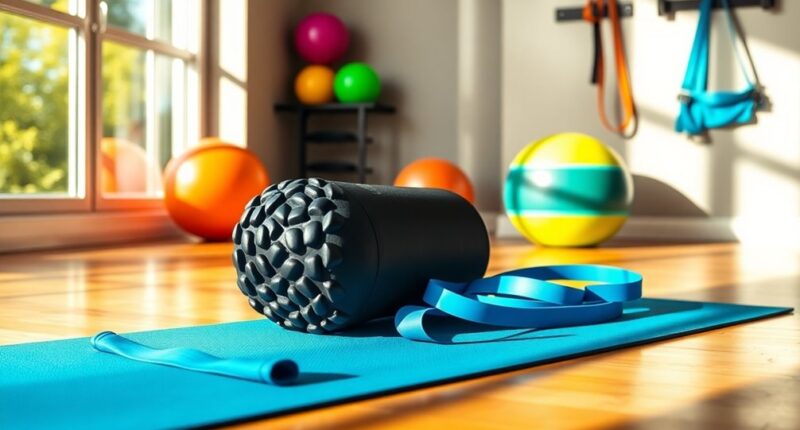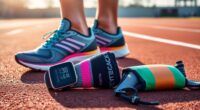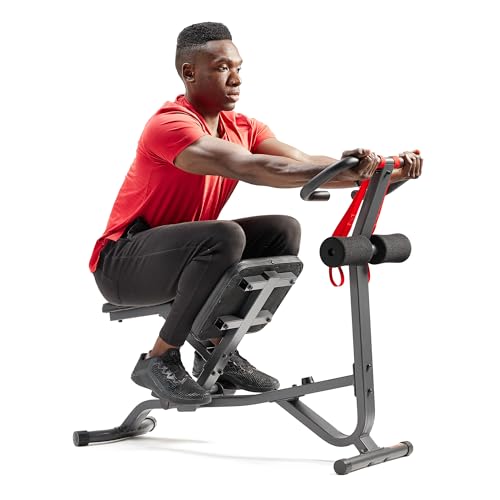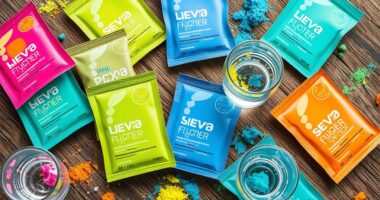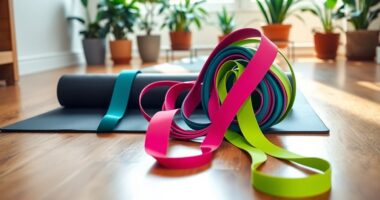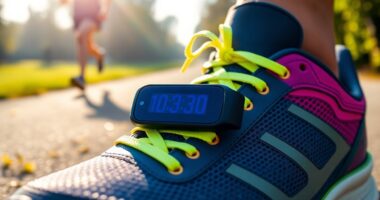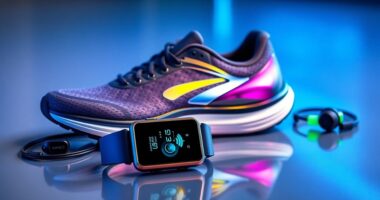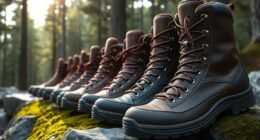I've found that using the right stretching equipment can really boost flexibility and performance for runners like us. I recommend the ProStretch Original Calf Stretcher for effective pain relief, along with the Foot and Calf Stretcher Stretching Strap for easy adjustments. The Slant Board's adjustable angles are also a game-changer. Additionally, resistance bands are great for strength training. If you're curious about even more options and tips, there's plenty more to explore!
Key Takeaways
- Stretching equipment like calf and foot stretchers alleviates pain and enhances flexibility, essential for runners.
- Resistance bands and stretching straps are ideal for improving recovery routines and overall muscle flexibility.
- Adjustable leg stretching devices cater to various body types, promoting safe and effective stretching.
- Foam rollers enhance blood circulation and relieve muscle tension, crucial for post-run recovery.
- Ergonomic, portable designs ensure user-friendliness and convenience for stretching at home or on the go.
ProStretch Original Calf Stretcher and Foot Rocker for Plantar Fasciitis
If you're struggling with plantar fasciitis or tight calves, the ProStretch Original Calf Stretcher and Foot Rocker might just be the perfect solution for you. I've found it incredibly effective for easing heel and foot pain while enhancing my flexibility. The unique rocker design isolates the lower leg muscles, making stretching feel more targeted and efficient. It's physician-endorsed and widely used in clinics, which gives me confidence in its effectiveness. Plus, combining it with night splints and orthotics has amplified my results. Just be mindful of the sizing, especially if you have larger feet. It's definitely worth a try!
Best For: Individuals suffering from plantar fasciitis, tight calves, or Achilles tendonitis who seek effective stretching solutions.
Pros:
- Effective pain relief for conditions like plantar fasciitis and Achilles injuries.
- Unique rocker design allows for targeted stretching of lower leg muscles.
- Physician-endorsed and widely used in physical therapy clinics, adding credibility to its effectiveness.
Cons:
- Sizing issues may arise, particularly for users with larger feet.
- Designed for one foot at a time, which may require additional products for comprehensive treatment.
- Optimal results depend on wearing rubber-soled shoes during use.
Foot and Calf Stretcher Stretching Strap for Plantar Fasciitis
The Foot and Calf Stretcher Stretching Strap is an essential tool for runners battling plantar fasciitis, heel spurs, or tight hamstrings. I've found it incredibly effective for alleviating pain and improving blood circulation. Its ergonomic design and durable nylon laminate make stretching easy and comfortable. I love how it can target not just my calves but also my hamstrings and Achilles tendon. The portability means I can take it anywhere, whether at home or the gym. Plus, the instruction manual is a great help for beginners. Just remember to listen to your body and seek medical advice if needed.
Best For: Individuals suffering from plantar fasciitis, heel spurs, tight hamstrings, or those seeking to improve overall flexibility and mobility.
Pros:
- Ergonomic design allows for comfortable and effective stretching.
- Portable and compact, making it easy to use at home, the gym, or while traveling.
- Includes an instruction manual, making it user-friendly for beginners and those in physical therapy.
Cons:
- Some users may experience discomfort in certain stretching positions, particularly with specific foot sizes.
- Initial learning curve may be needed for effective use.
- Not a substitute for professional medical care; users should seek medical advice if discomfort occurs.
Slant Board for Calf Stretching with Adjustable Angles
Runners seeking to alleviate calf tightness and enhance flexibility will find the Slant Board for Calf Stretching with Adjustable Angles an invaluable tool. With five adjustable angles, I can customize my stretches to suit my needs, whether I'm easing into a routine or tackling a more intense stretch. Weighing just a pound and made from eco-friendly materials, it's super portable and easy to store. I love that it's stain-resistant and easy to clean! Plus, physical therapists recommend it for recovery from common injuries. It's truly made a difference in my flexibility and overall performance as a runner.
Best For: Runners and individuals looking to improve calf flexibility and alleviate tightness in their muscles.
Pros:
- Adjustable angles provide customization for various stretching levels and routines.
- Lightweight and portable design makes it easy to store and transport.
- Recommended by physical therapists for effective recovery from common injuries.
Cons:
- Some users reported slight slipperiness when using certain types of shoes.
- Limited to calf stretching, may not address other muscle groups.
- Requires regular cleaning to maintain its stain-resistant properties.
Trideer Stretching Strap for Yoga and Exercise
For anyone looking to enhance their flexibility and recovery routine, the Trideer Stretching Strap is an excellent choice. I love how it's designed for yoga, physical therapy, and home workouts, making it super versatile. With 10 loops, I can easily adjust it for various stretches, which is perfect for beginners like me. The durable polypropylene material feels comfortable against my skin, even during intense sessions. Plus, it's lightweight and portable, so I can take it anywhere. I've found it especially helpful for easing joint pain and improving my muscle recovery. Trust me, this strap is a worthwhile investment!
Best For: Anyone looking to enhance their flexibility and recovery routine through yoga, physical therapy, or home workouts.
Pros:
- Durable Construction: Made from sturdy polypropylene with reinforced stitching, ensuring long-lasting use.
- Versatile Usage: Suitable for various exercises including yoga, Pilates, and rehabilitation, catering to a wide range of needs.
- User-Friendly Design: Features 10 loops for easy adjustments, making it accessible for beginners and effective for experienced users alike.
Cons:
- Non-Elastic Material: Some users may prefer a stretchy strap for certain exercises, which this non-elastic design does not provide.
- Limited Color Options: While available in a few colors, choices might be limited compared to other brands.
- Requires Proper Technique: Users need to be aware of proper stretching techniques to avoid injury, especially if new to these types of exercises.
Figure 8 Resistance Band for Exercise and Physical Therapy
Looking to enhance your stretching routine? The Figure 8 Resistance Band is a game-changer for my workouts. Crafted from natural latex, its unique shape fits perfectly for exercises targeting arms, shoulders, and back. I love how its anti-skid massage points add comfort during my sessions. This band is multifunctional, aiding everything from resistance training to physical therapy. It's helped me strengthen torn ligaments and improve my posture, reducing that hunchback look. Plus, it's portable—ideal for quick workouts at home or the gym. With positive reviews and a lifetime warranty, it's a solid investment for any runner.
Best For: Individuals seeking a versatile and effective tool for strength training, stretching, and rehabilitation, particularly those dealing with torn ligaments or looking to improve posture.
Pros:
- Multifunctional design suitable for various exercises including resistance training, yoga, and physical therapy.
- Portable and easy to use at home, the gym, or even the office for quick workouts.
- Positive customer feedback and a lifetime warranty provide reassurance of product quality and durability.
Cons:
- Some users have reported durability issues, with bands tearing after limited use.
- May not be suitable for individuals with latex allergies.
- Effectiveness can vary based on individual fitness levels and exercise routines.
OPTP The Original Stretch Out Strap for Physical Therapy and Yoga
If you're seeking a versatile stretching tool that enhances flexibility and promotes muscle recovery, the OPTP The Original Stretch Out Strap is an excellent choice. I've found it indispensable for yoga, physical therapy, and even Pilates. Its six-foot length and ten loops make it easy to use, whether I'm stretching my legs or focusing on knee therapy. Plus, the included exercise booklet and video guide offer a variety of stretches. Users rave about its durability, and I can attest to its effectiveness in improving my range of motion and reducing injury risk. It's a solid addition to my routine!
Best For: Individuals seeking to improve flexibility, muscle recovery, and range of motion through effective stretching techniques.
Pros:
- Durable and well-designed: Made from high-quality materials that resist wear and tear.
- Versatile use: Suitable for yoga, physical therapy, Pilates, and various stretching exercises.
- Includes instructional materials: Comes with a 40-page exercise booklet and video guide, enhancing user experience.
Cons:
- May require additional comfort: Suggested to use with a thicker exercise mat for optimal comfort during stretches.
- Learning curve for beginners: Users new to stretching may need time to familiarize themselves with the various techniques.
- Limited color options: The strap may only come in a few color choices, which could be a downside for those who prefer personalized aesthetics.
Leg Stretcher Strap for Dance and Yoga
The Leg Stretcher Strap stands out as an essential tool for dancers and yogis seeking to enhance their flexibility and prevent injuries. I love its user-friendly design; the soft, skin-friendly nylon feels great against my skin. With dimensions of 67 x 60 inches and an adjustable length, it's perfect for all fitness levels. It helps me achieve gradual stretches, increasing my range of motion safely. Plus, it's easy to clean! Whether I'm practicing aerial yoga or ballet, this strap supports my routine. With a 60-day warranty, I feel confident trying it out—what's not to love about that?
Best For: Dancers and yogis of all ages and fitness levels looking to enhance flexibility and prevent injuries.
Pros:
- User-friendly design with soft, skin-friendly nylon for comfortable use.
- Adjustable strap length allows for personalized stretching experiences.
- Versatile for various activities including aerial yoga, ballet, and postnatal recovery.
Cons:
- Some users report issues with fabric quality, affecting durability.
- Assembly may be challenging for some, leading to frustration.
- Average rating of 3.8 stars suggests mixed customer experiences.
6 in 1 Foam Roller Set for Deep Muscle Massage and Yoga
For runners seeking effective recovery tools, the 6 in 1 Foam Roller Set stands out as an essential companion. This set includes a hollow foam roller, massage balls, a yoga stick, and a stretching band, all designed to enhance muscle recovery. I love how the foam roller mimics a massage therapist's hands, deeply targeting sore muscles. The massage balls are perfect for those hard-to-reach spots, while the elastic bands help stretch out tight areas post-massage. Plus, it's all portable, fitting neatly into a stylish carrying case. It's my go-to for quick muscle relief and improved flexibility after runs.
Best For: Runners and athletes looking for effective muscle recovery tools to relieve soreness and improve flexibility. These tools are designed to target specific muscle groups and help alleviate the tension that often accompanies intense physical activity. By incorporating techniques such as foam rolling and massage therapy, these devices not only promote quicker recovery but also enhance overall performance. As such, they are considered some of the best flexibility recovery tools on the market, making them essential for any serious runner or athlete.
Pros:
- Enhances blood circulation and relieves muscle tension effectively.
- Portable design with a stylish carrying case, perfect for on-the-go use.
- Versatile components cater to various muscle groups and recovery needs.
Cons:
- Some users report variations in firmness and material quality.
- May not provide enough pressure for individuals seeking a firmer massage experience.
- Limited effectiveness for larger muscle groups compared to professional massage therapy.
3 Bar Leg Stretcher – Stainless Steel Hamstring Stretcher Device
Designed with adjustable features, the 3 Bar Leg Stretcher is perfect for runners looking to enhance their flexibility and prevent injuries. This stainless steel device accommodates various body types, with an impressive range of 21.8 to 40.27 inches and up to 180° of pull. I love the ergonomic, non-slip memory foam handles that provide a secure grip during use. Users, including myself, have noticed significant improvements in flexibility and reduced discomfort, especially in the hamstrings and inner thighs. Just remember to warm up before stretching, and you'll be ready to enjoy the benefits of this effective and affordable tool.
Best For: The 3 Bar Leg Stretcher is best for athletes, dancers, and fitness enthusiasts looking to improve flexibility and prevent injuries.
Pros:
- Adjustable design accommodates various body types and stretching needs.
- Durable construction with powder-coated stainless steel ensures long-lasting use.
- Ergonomic, non-slip memory foam handles provide comfort and secure grip during stretching.
Cons:
- Some users report concerns about the sturdiness of connection points.
- Initial awkwardness in use may deter novice users.
- Lack of detailed stretching instructions in the manual could be a drawback for beginners.
Multifunction Tension Rope Fitness Equipment
A standout feature of the Multifunction Tension Rope Fitness Equipment is its six pull ropes, which deliver superior tensile strength and elasticity, making it an excellent choice for runners looking to enhance their flexibility and strength. This lightweight, portable tool is perfect for workouts at home, in hotels, or even outdoors. I love how it effectively targets my arms, tummy, shoulders, legs, and butt. The superior foam grips provide comfort and prevent slipping during exercises. While some users have reported durability issues, I've found it to be a versatile addition to my routine, increasing my range of motion and reducing injury risks.
Best For: Individuals seeking a versatile and portable fitness solution to improve their strength and flexibility without the need for a gym.
Pros:
- Effective for full-body workouts, targeting multiple muscle groups including arms, legs, and core.
- Lightweight and portable, making it easy to use at home, in hotels, or outdoors.
- Comfortable foam grips that enhance user experience and prevent slipping during exercises.
Cons:
- Resistance may be too high for seniors or individuals with reduced strength, limiting usability.
- Not suitable for taller individuals due to length constraints, potentially affecting exercise effectiveness.
- Reports of uneven tube lengths, which can lead to unbalanced strength during workouts.
Foam Roller Set for Whole Body Physical Therapy & Exercise
The Foam Roller Set stands out as the ultimate choice for runners seeking effective recovery tools. It includes a high-density foam roller, massage stick, Peanut Massage Ball, and more, all designed for whole-body therapy. I've found that using it pre- and post-workout really boosts my blood flow and helps reduce muscle soreness. The materials are sturdy and noise-free, making it a great companion for any routine. Plus, the portable nylon bag makes it easy to take anywhere. With positive user feedback and a handy massage guide, this set's definitely helped enhance my flexibility and performance!
Best For: Runners and athletes looking for effective tools to enhance recovery, relieve muscle soreness, and improve flexibility.
Pros:
- High-density foam roller supports up to 300 lbs and retains its shape for long-lasting use.
- Portable nylon bag allows for easy transport, making it ideal for travel or use at the gym.
- Positive user feedback highlights the effectiveness of the set in improving performance and aiding recovery.
Cons:
- Some users suggested that the massage balls could be softer for a more comfortable experience.
- Additional round balls could enhance versatility for varied massage techniques.
- May not be suitable for those with sensitivity to certain textures or materials.
PowerStep UltraFlexx Foot Rocker for Stretching and Pain Relief
For runners grappling with foot and lower leg pain, the PowerStep UltraFlexx Foot Rocker stands out as a game-changer. It holds your foot in the right position, providing a deep stretch that targets muscles, ligaments, and tendons. I've found it especially helpful for conditions like Plantar Fasciitis and Achilles Tendonitis. The non-skid bottom guarantees stability while I stretch, and its design accommodates various foot sizes. Regular use not only relieves pain but also boosts flexibility and strength, making it perfect for my daily routine. Overall, it's a must-have for any runner looking to enhance recovery and performance.
Best For: The PowerStep UltraFlexx Foot Rocker is best for runners and individuals experiencing foot and lower leg pain, including conditions like Plantar Fasciitis and Achilles Tendonitis.
Pros:
- Effective Pain Relief: Provides significant relief for various foot-related ailments.
- Improves Flexibility and Strength: Regular use enhances flexibility and strengthens lower leg muscles.
- Stable and Versatile Design: Features a non-skid bottom and accommodates different foot sizes for convenient use.
Cons:
- Mixed User Feedback: Some users report limited effectiveness for their specific issues.
- Requires Consistent Use: Benefits may take time to manifest, necessitating regular usage for optimal results.
- May Not Suit All Foot Types: Users with very unique foot shapes may find it less comfortable or effective.
Slant Board 3pcs Calf Stretcher for Physical Therapy
Ideal for runners seeking relief from foot and calf discomfort, the Slant Board 3pcs Calf Stretcher is a versatile tool designed for effective physical therapy and rehabilitation. With its two pieces at an 8.5° incline and one at 17°, I can easily adjust the stretch intensity to fit my needs. The lightweight, eco-friendly material holds up to 440 lbs, making it durable and portable for use at home or the gym. I've noticed improvements in my flexibility and reduced pain from conditions like plantar fasciitis. Plus, the 100% satisfaction guarantee gives me confidence in my purchase.
Best For: Runners and individuals seeking relief from foot and calf discomfort, as well as those undergoing physical therapy for conditions like plantar fasciitis and Achilles tendonitis.
Pros:
- Versatile Incline Options: Includes two pieces with an 8.5° incline and one with a 17° incline for customizable stretch intensity.
- Durable and Lightweight: Made from eco-friendly materials, it supports up to 440 lbs while remaining portable and easy to store.
- Improves Flexibility and Strength: Users report enhanced lower leg flexibility and strength, reducing the risk of injury.
Cons:
- Slipperiness: Some users experience slipperiness when using the board with socks, recommending shoes for better traction.
- Limited Size Options: The compact dimensions may not suit everyone's preferences for stretching surfaces.
- Learning Curve: New users may take time to find the best position and angle for their specific needs.
IdealStretch Original Hamstring and Lower Back Stretcher
Looking for a versatile stretching solution that caters to various needs? The IdealStretch Original Hamstring and Lower Back Stretcher has been a game changer for me. With its durable steel frame and lightweight design, it targets tight hamstrings, lower back, and calves effectively. I appreciate how it's recommended by healthcare professionals for pain relief, especially for sciatica. The included instructional card makes positioning easy, so I can stretch with confidence. While it's a bit pricey, the benefits for flexibility and muscle relief are worth it. Overall, this stretcher has become an essential part of my routine.
Best For: The IdealStretch Original Hamstring and Lower Back Stretcher is best for athletes, seniors, individuals in injury recovery, yogis, and dancers seeking relief from tight muscles and improved flexibility.
Pros:
- Effective for alleviating pain in hamstrings, lower back, and calves.
- Lightweight and user-friendly design with clear instructional card for easy positioning.
- Recommended by healthcare professionals for its benefits in flexibility and muscle relief.
Cons:
- Considered pricey by some users, leading to perceptions of poor value for materials.
- Reports of missing components, such as DVDs and wedges, causing frustration.
- Some users experienced discomfort during use, indicating a potential need for adjustment.
Sunny Health & Fitness Full Body Inversion Traction & Stretch Decompression Machine
The Sunny Health & Fitness Full Body Inversion Traction & Stretch Decompression Machine stands out for its padded foam rollers, making it a perfect fit for runners seeking relief from lower back pain and improved flexibility. I love how it targets various areas with its multi-grip handles and provides over 24 inches of stretching. It's compact and easy to store, which is great for my home gym. Plus, the instructional placard makes it simple to follow along with nine different stretches. While taller users might need extra support, I've found it effective and affordable compared to pricier alternatives.
Best For: Runners and individuals seeking relief from lower back pain and improved flexibility in a compact and affordable stretching solution.
Pros:
- Padded foam rollers provide comfort during use.
- Multi-grip handles allow for targeting specific areas effectively.
- Instructional placard included for easy guidance through nine different stretches.
Cons:
- May not be suitable for larger individuals due to stability concerns.
- Taller users (over 6 feet) may require additional support under the legs/knees.
- Ankle supports could be more comfortable for extended use.
Factors to Consider When Choosing Stretching Equipment for Runners
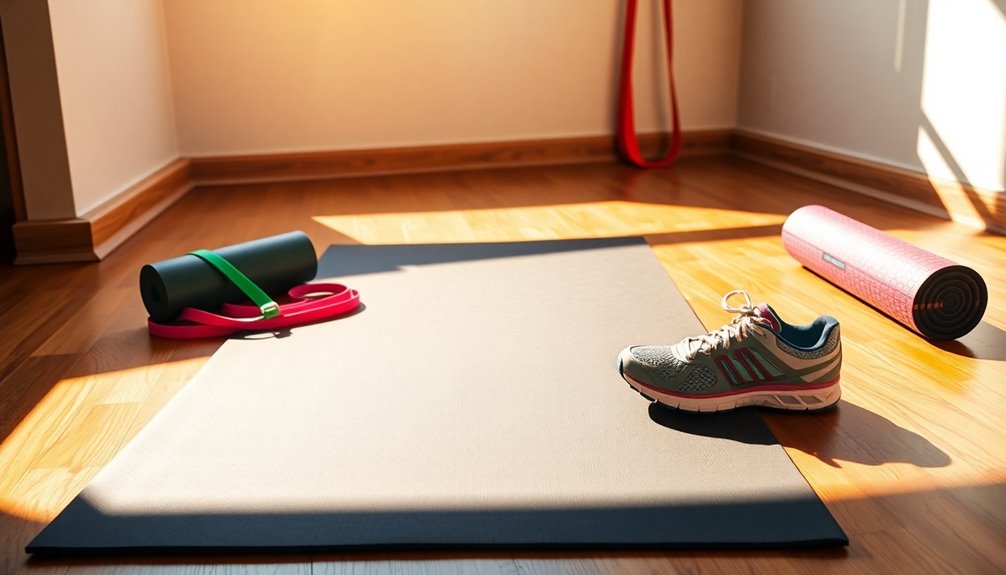
When I'm choosing stretching equipment for my runs, I focus on several key factors. I'll evaluate the types available, their key features, and how portable they are for my space. Safety and adjustability for different users also play a big role in my decision-making process.
Types of Stretching Equipment
Selecting the right stretching equipment can make a significant difference in a runner's performance and recovery. I've found that calf stretchers and foot rockers are excellent for alleviating pain from conditions like plantar fasciitis and Achilles tendonitis, as they effectively isolate lower leg muscles. Stretching straps, with their multiple loops, are perfect for beginners and versatile enough for targeting hamstrings, quadriceps, and back muscles. I also appreciate slant boards; they allow me to customize calf stretches at various angles, matching my fitness level. Additionally, foam rollers and massage balls are essential for muscle recovery—they relieve soreness and boost blood circulation through self-myofascial release. Each piece of equipment serves a unique purpose, enhancing my overall flexibility and performance as a runner.
Key Features to Evaluate
Finding the right stretching equipment goes beyond just knowing the types available; it's about understanding what features will best support my needs as a runner. I look for adjustable angles or resistance levels that let me customize the intensity of my stretches. User-friendly designs, like ergonomic shapes and clear instructions, make it easier to use effectively. Durability is key, so I prefer materials that are non-toxic and easy to clean, ensuring they're hygienic and long-lasting. It's also essential to choose equipment that targets muscle groups I rely on most, like my calves, hamstrings, and lower back, to help relieve tightness and prevent injuries. These features help me enhance my flexibility and performance on the run.
Portability and Storage Options
Portability and storage are essential factors for me when choosing stretching equipment as a runner. I always look for lightweight and compact options that I can easily transport, whether I'm at home, the gym, or on the go. It's vital that the equipment can be folded or disassembled for convenient storage, so it doesn't clutter my space. Some devices even come with carrying cases, which makes them perfect for outdoor workouts or travel. I also evaluate the weight capacity to guarantee it meets my needs without sacrificing portability. Choosing durable yet lightweight materials is a must, as this not only enhances portability but also guarantees the equipment lasts over time, making it a smart investment.
Safety and Stability Factors
When I'm choosing stretching equipment, safety and stability are at the top of my list. I always look for a non-skid base or material to prevent slipping during my stretches. It's vital that the equipment can handle my weight, so I check for a maximum weight limit that meets or exceeds my own. Additionally, I prefer products made from durable, high-quality materials that hold up over time. Clear instructions or guides are essential too; they help me use the equipment properly and minimize the risk of injury. Finally, while adjustable features are important for accommodating different body types, I focus primarily on how these aspects contribute to a safe and stable stretching routine.
Adjustability for Different Users
After guaranteeing safety and stability, I turn my attention to adjustability in stretching equipment. I look for features like multiple angles and lengths to accommodate various body types and flexibility levels. Customizable resistance or height settings are vital, as they let me gradually increase stretch intensity as I improve. It's also important to take into account the maximum weight capacity to ascertain the equipment can safely support all users, especially heavier individuals. Adjustable straps or loops enhance usability, allowing me to modify my grip or foot placement for ideal comfort. Additionally, equipment designed for multiple orientations offers versatility for different stretching routines, meeting the diverse needs of all users. This adaptability ultimately boosts my stretching effectiveness and overall performance.
Material Quality and Durability
While I appreciate the importance of adjustability, the material quality and durability of stretching equipment are equally vital for my routine as a runner. I always look for items made from high-density foam or reinforced nylon, which can endure repeated use without losing their shape. Non-toxic, water-resistant, and eco-friendly materials not only guarantee my safety but also add to the longevity of my gear. I prefer equipment with durable stitching and reinforced seams to prevent wear and tear. It's also essential that the equipment supports substantial weight limits, typically between 250-480 lbs, indicating solid construction. Finally, I value easy maintenance, so materials that repel liquids or allow for a quick wipe-down contribute greatly to durability.
Versatility for Various Stretches
Choosing the right stretching equipment means considering how versatile it is for various stretches. I always look for tools that accommodate multiple body parts, letting me effectively stretch my calves, hamstrings, quads, hips, and back. This versatility helps enhance my overall flexibility and prevents injuries. Equipment with adjustable angles or multi-loop designs offers a range of intensity, catering to my individual needs. I appreciate tools that support both static and dynamic stretches, making them great for warm-ups and cooldowns. Plus, I prefer products I can use at home, in the gym, or outdoors. A portable, lightweight design is a must, ensuring I can easily carry my stretching equipment and stick to a consistent routine before and after my runs.
Budget Considerations and Value
When it comes to selecting stretching equipment, budgeting plays an essential role in ensuring I get the best value for my investment. I find that quality can vary greatly, so I always compare price ranges carefully. Investing in durable equipment might seem costly upfront but saves money in the long run by reducing replacements. I also look for versatile tools that can serve multiple stretching needs, eliminating the need for extras. Many products come with warranties or satisfaction guarantees, providing peace of mind. Finally, I consider the health benefits—improved flexibility and reduced injury risk—justifying higher costs through better performance and fewer medical bills. Balancing quality and budget is key to making the right choice.
Frequently Asked Questions
How Often Should I Use Stretching Equipment as a Runner?
I usually incorporate stretching equipment into my routine about three to four times a week. It helps me maintain flexibility and prevent injuries. I've found that using tools like resistance bands or foam rollers after my runs really makes a difference. I listen to my body, so if I feel tightness, I'll stretch more often. Consistency is key, and I've noticed improved performance when I stick to this schedule.
Can Stretching Equipment Prevent Running Injuries?
Did you know that studies show about 50% of runners experience injuries each year? I've found that using stretching equipment can definitely help prevent these injuries. By incorporating tools like resistance bands or foam rollers into my routine, I'm able to target specific muscles and improve my overall flexibility. This not only enhances my performance but also keeps me feeling strong and less prone to those nagging injuries that can sideline me.
What Is the Best Time to Stretch Before or After Running?
I've found that the best time to stretch is after a run. My muscles are warmed up, and I can really focus on improving flexibility. Stretching beforehand can sometimes lead to injuries if I'm not careful. I like to do dynamic stretches before running to warm up, but static stretching afterward helps me recover and stay limber. Listening to my body has always guided my stretching routine effectively. What about you?
Are There Any Risks Associated With Using Stretching Equipment?
Did you know that around 30% of runners experience injuries related to improper stretching techniques? I've found that using stretching equipment can definitely pose risks if not used correctly. It's easy to overdo it, leading to strains or tears. I always make sure to read the instructions and start slowly. Proper form is essential, so I take my time and listen to my body to avoid any unnecessary injuries.
How Do I Clean and Maintain My Stretching Equipment?
I always make sure to clean my stretching equipment regularly. For fabric items like straps or mats, I use a mild detergent and water, wiping them down with a soft cloth. For non-fabric items, like foam rollers, I spray them with a disinfectant and let them air dry. I also check for any signs of wear or damage to keep everything in good condition. Regular maintenance really helps extend the life of my equipment.
Conclusion
In summary, investing in the right stretching equipment can transform your running game from ordinary to extraordinary! Picture yourself gliding effortlessly over the pavement, each stride a validation of your newfound flexibility and performance. With these tools at your disposal, you'll feel like a superhero, conquering every mile with ease. So, don't just stretch—elevate your routine and release the runner within you! Embrace these must-have items and watch your running journey soar to unimaginable heights!
